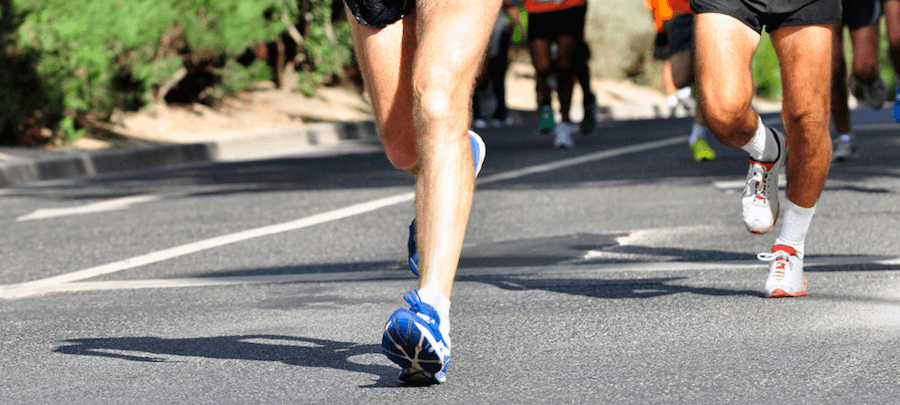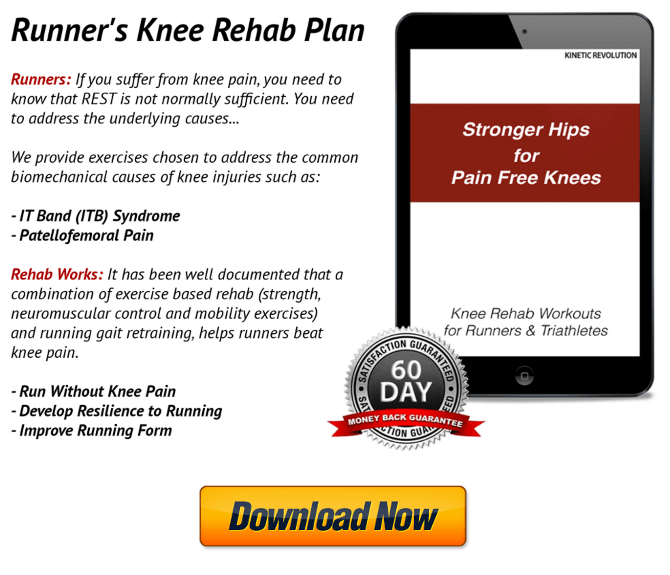
When it comes to common overuse injuries in runners, PFS (patellofemoral syndrome) is without a doubt one of the top five. In addition to affecting as many as 1 in 4 runners, it’s also one of the trickier injuries to fix.
Why? In true overuse fashion, PFS is a symptom of a bigger problem.
The big thing to remember about PFS (and knee problems in general) is the ‘overuse’ nature of the injury. This essentially means that the knee is getting beat up as the middle man in the leg chain.
It also means that it has been stuck in this position for a while and is only now breaking down to the point where it’s symptomatic and limiting.
In a normal leg, the knee is able to absorb the impact and workload from the foot/ankle and then transmit it up the leg for the large hip muscles to absorb and use to propel you forward.
If that is not allowed to happen, then the workload remains down in the leg at the knee. Now, instead of pushing off with the large glute muscles, you wind up pulling yourself forward using the hamstrings and adductors. While the glutes help externally rotate the leg, the adductors and hamstrings produce the opposite rotation.
Here’s a quick test to show you what I mean:
- Stand up with your feet hip width apart. Keep your knees straight (though not locked). Squeeze your glutes! As you do so you will feel your thighs rotating out. If you do this in front of a mirror you can see how the knee cap gets pulled laterally (towards the outside of the leg).
- Now, try it a second time but instead of squeezing your glutes squeeze your adductors (inner thigh muscles) together. See how this has the opposite effect? It pulls your knee cap in as it rotates your thigh in.
That internal rotation is a big driving force behind PFS pain. As the femur rotates, the groove that the patella sits in is moved as well. Now instead of sitting happily where it should, it’s getting pulled to the edge and ground over the bone.
Once that inflammation cycle starts the only way to get rid of it is take pressure off the knee cap but reversing the rotation and restoring normal alignment to the knee and leg.
What Do PFS Problems Look Like In the Early Stages?</2>
Noisy Knee Caps
Are you one of those people who’s knees caps crack or pop every time you bend down to tie your shoes?
This is a warning sign that you’re knee cap is being pulled out of it’s normal position. While the noise alone isn’t something to worry about, the frequency of that noise is something that you definitely need to be paying attention to.
Cracking and popping left unchecked will eventually lead to grinding and audible creaking that are much, much harder to get rid of.
Duck Walking / Pigeon Toes
Have you ever noticed that your toes point out (duck walk) or in (pigeon toed) when you walk and run?
If you haven’t, has one of your training partners ever mentioned it? Both of these are warning signs that there are some serious mobility restrictions in your foot and ankle.
If you are unable to come forward over your ankle, the body will compensate by rotating your foot in our out so that you don’t trip and fall over it.
The real problem with this is that if the lower leg starts rotating, the upper leg will need to rotate as well. It can either go with it, or it can rotate in the opposite direction to try and balance things out.
Doesn’t sound very nice to the poor knee stuck in the middle does it?
New Calluses/Wear on Shoes
New blister and callus patterns are a great warning sign that your foot is working harder than it should be. This is typically common under or on the inside edge of the big toe or along the outer ridge of the foot.
An easy way to look at it is this. When the foot makes contact, it “rolls” to absorb impact and transfer it from the outer part of the foot over to the big toe to prepare for push off/propulsion. This allows the ankle and calf to do the heavy lifting.
If you’re getting new blisters in the same spots or calluses, then something is off and that foot is “rolling” more/less than it should.
Another thing to look at here is are the backs of your shoes vertical when you look at them? Or are they tilted in or out? Does your big toe pop through the top mesh after a hundred miles?
Chronically tight calves and hamstrings
Chronic tightness in the posterior chain (muscles along the backside of the legs) is a warning sign.
In a normal leg, the workload is shared between the big muscle groups. It also means that as every muscle contracts, it has the opportunity to relax before the next contraction. A muscle that doesn’t relax will always stiffen and will eventually get stuck that way.
Since both the gastrocnemius and hamstring muscles criss-cross behind the knee, restrictions in both will pull on the retinaculum, pulling that knee cap even tighter against the bone.
Popping Hip
Just like noisy knees, noisy hips are a warning sign that the alignment is off and that tendons are being pulled out of their grooves. Just like the knees, the noise itself isn’t bad but increasing frequency or the feeling that things are getting stuck definitely are things to pay attention for.
Pay Attention!
The great thing about warning signs is just that! They warn us that we need to start paying attention. If you find yourself experiencing any of the signs above, here are a few tips to start loosening up those knees.
The easiest and cheapest way to go after muscles is always to break out the foam roller. Here are some tips to walk you through a session with the roller using three techniques.
- Typically I start off with 2-3 minutes with the foam roller. The goal here isn’t to beat my legs up so they’re sore/bruised for the rest of the week. It’s to get some slack in there and find where the “problem spots” are (aka ‘where it hurts the most’).
- From there I like to use mobilizations to free up both ends of the leg chain: the ankle and hip. I also like to dig a little deeper into the sorest muscle groups.
- Lastly, I always follow it up with stretching. Frequency trumps everything with these. Aim to get in 1-2 reps every few hours versus one killer stretch session at the end of the day. Here’s a video to walk you through the stretch routine.
Try This Routine
Here’s a quick five minute routine:
- One minute with the foam roller each muscle group (calf, hamstrings, quadriceps, adductors, ITB, hip flexors).
- Mobilization techniques: 5 reps nice and easy. (hip, ankle, big toe; quads, hamstrings, calf).
- Stretches: 2 x 20 seconds calf, hamstrings, adductors, hip flexors and piriformis.
The post Warning Signs For Runner’s Knee (Patellofemoral Syndrome) appeared first on Run Coaching, Ironman and Triathlon Specialists - Kinetic Revolution.
from Run Coaching, Ironman and Triathlon Specialists - Kinetic Revolution http://feedproxy.google.com/~r/KineticRev/~3/D0jtAnR4Wos/


No comments:
Post a Comment